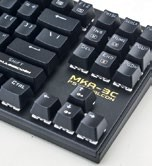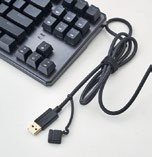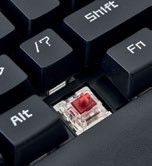The ‘click clack’ of mechanical keyboards is everywhere these days, but the fact remains that many of them are still really expensive. Or are they?


The ‘click clack’ of mechanical keyboards is everywhere these days, but the fact remains that many of them are still really expensive. Or are they?



Armaggeddon’s MKA-3C Psychfalcon keyboard is targeted not at keyboard enthusiasts, but at gamers on a budget who want to see what the fuss over mechanical keyboards is about.
For starters, the keyboard feels fairly weighty at 976g. It’s de nitely not as solid or heavy as something like a Filco, but it doesn’t feel like something you picked up from the bargain bin either. The metal body feels stiff and rigid, with no discernible flex to its chassis.
The Psychfalcon is outfitted with Outemu Blue switches, which are very similar to Cherry MX Blues. They are tactile and clicky, and feature an operating force of around 60g. The very distinct click that comes with every key press means that they are also very noisy to type on, so you’ll want to bear that in mind if you intend to use this keyboard in the office.
These switches are also modular and hot swappable, so you can pluck them out and replace them with a new switch if you do get bored of how they feel. That’s similar to what Tecware offers, and it’s nice to see this level of flexibility at this price point.
The keycaps are constructed out of ABS plastic, which is known to wear easily and take on an unpleasant shine over time. Still, this is pretty much standard fare for most keyboards, even those that cost twice or even triple the price, so I can’t really fault Armaggeddon here.
The secondary legends are pad-printed below the translucent legends, with clear labels for various media control functions and lighting modes. The legends are printed as quite a thick layer over the keycaps, and you’ll notice them the minute you run your finger over the keycaps.
That said, pad-printing is way less durable than something like doubleshot molding, which the Tecware keyboard uses.
Finally, the Psychfalcon features RGB lighting for those who like their LEDs. The good news is that the lighting is quite even, as the keycaps with dual legends have them sitting side by side, so they’re both sitting directly above the LED.
The keyboard supports true driverfree operation, and you’re meant to do everything on the keyboard itself. However, this means you don’t get more advanced features such as per-key RGB backlighting and are limited to just nine different lighting effects and nine game lighting profiles.
AT A GLANCE
SWITCHES
Outemu Blue
TYPE
Tactile and clicky
DIMENSIONS
355.8 x 135.9 x 38.6mm
WEIGHT
976g
PRICE
$59.90















The Yuemi MK01 is a mechanical keyboard sold by smartphone juggernaut Xiaomi. It stands out immediately for its elegant, all-white design, a welcome departure from the RGB LEDs and more gamer-oriented designs of the Armaggeddon and Tecware keyboards.
Fortunately, it doesn’t just look pretty, and the keyboard is also quite solidly constructed. After all, the chassis is built mainly out of aluminum and the switches are mounted to a steel backplate for extra rigidity. The keyboard feet feel particularly sturdy as well, and they snap out with a reassuring click.
I also like the detachable cable, and it’s the only keyboard of the lot to have this. The top plate comprises a glossy plastic finish that may turn some folks away, but fortunately fingerprints don’t show up too egregiously.
The TTC Red switches are yet another clone of the original Cherry MX Reds, and they do feel smoother than the KRGD Reds on the Leobog K23. The silent and linear Red switches are especially suited for gaming, but typists will have a hard time not bottoming out given how light they are. What’s interesting is that the spacebar uses a black switch instead of red, so it feels heavier than the rest of the keys.
The polycarbonate/ABS keycaps have a matte texture that feels better than most ABS keycaps, and the translucent lettering comprises a separate piece of plastic so they’ll never fade.
That said, the MK01 is still a fairly basic keyboard. There’s just a single-color white backlight, although you can toggle between six different brightness levels on the keyboard itself. There are also no secondary media keys as on the other keyboards, and there’s no ability to reprogram any of the keys.
Hitting the Fn and Windows key does deactivate the Windows key however, so that can be pretty useful.
The keyboard’s minimalist aesthetic is also uninterrupted by any LED indicators, and the Caps Lock and Scroll Lock keys glow orange when they’re activated.
Unfortunately, one area where the MK01 is severely lacking is a key rollover feature. It doesn’t have N-key rollover, or anything close to that. In fact, I was able to make it stop registering additional key presses after holding certain combinations of just two keys.
That’s abysmal, especially for gaming, so I definitely wouldn’t recommend this if you’re looking for a gaming keyboard.
AT A GLANCE
SWITCHES
TTC Red
TYPE
Linear and silent
DIMENSIONS
350 x 128 x 31.6mm
WEIGHT
940g
PRICE
299 yuan








TECWARE PHANTOM RGB
The Tecware Phantom RGB may be one of the most impressive sub-$100 mechanical keyboards around. It is the most expensive keyboard in this shootout, but that isn’t saying a lot considering that it still costs just $69. For that price, you get plenty of features usually reserved for more expensive models, such as per-key lighting customizations, doubleshot keycaps, and modular switches. It also supports full N-key rollover, whereas the other keyboards falter in this area. The Phantom could use some refinement in the design department, but it’s otherwise difficult to find fault with.
By Koh Wanzi Photography by Darren Chang Yimin Art Direction by Orland Punzalan























